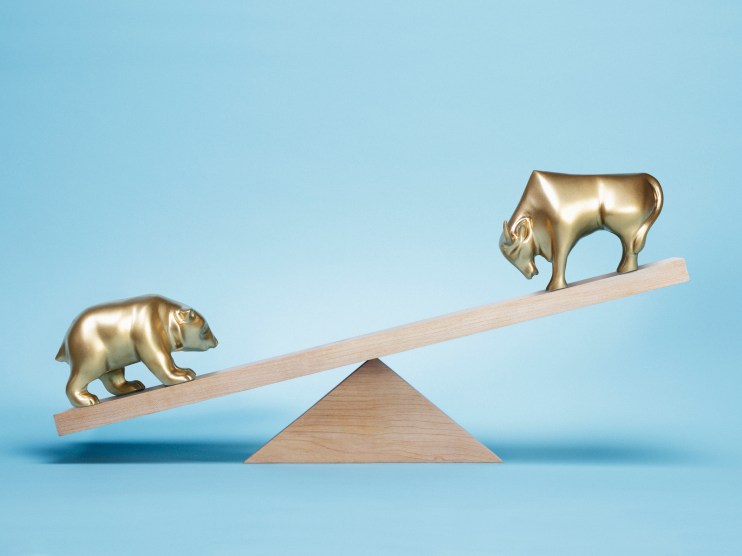
What are bull and bear markets?

TLDR
Bull market 👍
Bear market 👎
The terms “bull” and “bear” can be used to describe the behaviour and condition of financial markets or individual assets, reflecting substantial trends of 20% either upwards or downwards respectively, typically over a sustained period of time.
They are also terms that reflect the sentiment of investors. Investors being categorised as “bullish” are seen as having an optimistic view on investments, while “bearish” investors are perceived as having a pessimistic outlook on investments.
Both market types come with their own pros and cons, with investors being able to take advantage of either market condition once they have sufficient knowledge of each.
Definitions
Bull: refers to an optimistic period of growth in a financial market. It is typically seen when the economic situation is favourable, reflecting a level of confidence in investors who will typically be buying and HODL-ing during this time.
Bear: refers to a pessimistic period of decline in a financial market. It is typically seen when there is a loss of confidence in the economy and investors are selling their investments as they anticipate cutting their losses from the dip they are anticipating.
What is a bull market?
A bull market can be identified by upward growth, with a 20% increase over time being the most commonly accepted benchmark used to signal whether a market is bullish. During this time, confidence is high with demand outdoing supply, which sees a rise in prices.
“Investing in a bull market can be rewarding, everything you invest in seems to go up and the biggest risk is your ego. You can get carried away in thinking you have a hold over the market and are a genius. Whilst I am a firm believer in backing yourself and making the winners count, you need to make sure you have a plan to get out, to book some profit along the way and ensure that when the tide comes out, you haven’t been swimming naked (cc. Warren Buffett). In short, my approach in a bull market is to make the investments risk free or as close to risk free as soon as you can.” – Sam North of the eToro Academy
A “bullish investor” is someone who believes the price of investments will rise, leading to significant gains. The term reflects the sentiment of the investor as to how they anticipate a market or financial instrument will progress. They are optimistic about the outcome and are afraid to miss out on benefitting from potentially higher prices. While the investing behaviour of these individuals is that they are more likely to buy, it is not uncommon that bullish traders will HODL in anticipation of a market uptick.
What is a bear market?
A bear market can be identified by a decrease in growth, with a 20% decrease over time being the most commonly accepted benchmark used to signal if a market is bearish. During this time, the supply tends to be greater than the demand, with a more pessimistic outlook being the general consensus.
“In a bear market, there are ways of making money. Certain stocks will still perform, safe haven products like Gold and the US Dollar in theory should also benefit. From a long term point of view, a bear market isn’t the worst thing in the world as it can give you an opportunity to buy the stocks you like at a discounted price. 2008 and 2020 were generational buying opportunities. The mistake people can make is buying too aggressively on a market dip once the fundamentals have changed and trying to catch a falling knife. There is no harm in not timing the exact bottom of the market and remember loss of opportunity is always better than loss of capital.” – Sam North of the eToro Academy
A “bearish investor” is someone who believes the price of investments will fall, resulting in financial losses. Their investing behaviour is likely to reflect their anticipation as they are more typically driven to sell to cut their losses.
Why the bull and the bear?
There are some much-debated theories on why these animals found a place in the realms of financial terminology.
The most widely accepted story is that the phrases were coined based on how the animals attacked their prey. Bears are known to strike downwards, whereas bulls charge and thrust their horns in an upward motion.
Regardless of their origins, there is no doubt that the imagery of the bull and the bear are cemented as metaphors in the financial markets. Perhaps they are perfect symbols, reflecting the force of impact that both positive and negative movements have on the markets.
As the sleepy bear winds down for hibernation, all eyes will shift to the bull, horns gleaned and ready to charge on ahead.
Learn more about the ins and outs of investing with the eToro Academy, a free resource for those who know that knowledge is key when it comes to investing.
Check out the eToro Academy here.
This communication is for information and education purposes only and should not be taken as investment advice, a personal recommendation, or an offer of, or solicitation to buy or sell, any financial instruments. This material has been prepared without taking into account any particular recipient’s investment objectives or financial situation, and has not been prepared in accordance with the legal and regulatory requirements to promote independent research. Any references to past or future performance of a financial instrument, index or a packaged investment product are not, and should not be taken as, a reliable indicator of future results. eToro makes no representation and assumes no liability as to the accuracy or completeness of the content of this publication.